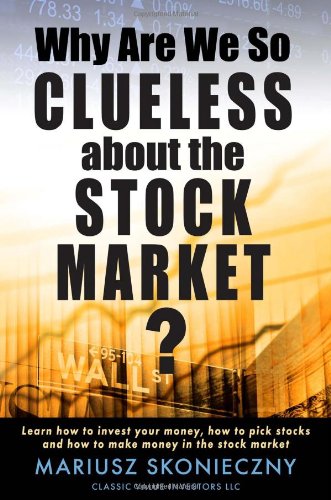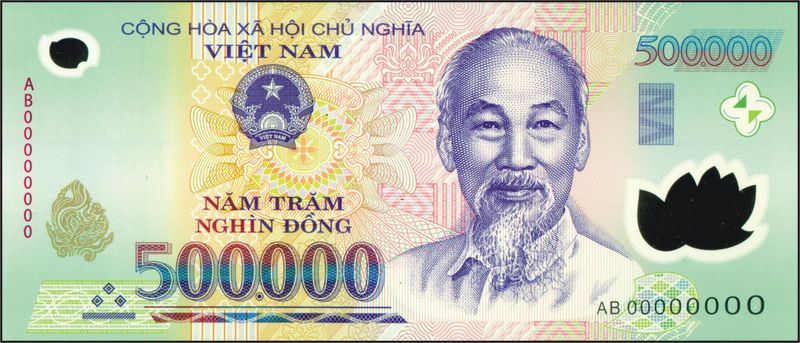Earlier this week, the earnest and sincere Mariusz Skonieczny, a professional money manager, asked us to review his book, Why Are We So Clueless About the Stock Market? It’s about how to properly value companies, and how to avoid investing foolishly.
The poor guy didn’t know what he was getting into, asking a stranger who happens to be a style martinet for a critique. At Control Your Cash, our primary passion is (obviously) personal finance. Our secondary passion is clarity. If we’re going to take it upon ourselves to communicate with you, we owe it to you to entertain and inform you. You can only blow 168 hours a week online, so we try to make your time here worth your while: something every content creator should take to heart.
ADDENDUM, 11:07 PM PT, May 24: I (Greg) posted this review a few hours ago. (I never write in the first person, so you know this is important.) The review might seem cruel in places, where I criticize Skonieczny for having a bland writing style. But there’s one little hitch.
Mariusz Skonieczny lives a couple of hours outside of Chicago, which of course is home to more Poles than any city outside Poland. Because he writes in fully functional English, I assumed he was 3rd-, 4th, or higher-generation Polish-American and that his parents, for whatever reason, chose to give him an ethnically authentic name.
No, Mariusz Skonieczny is Polish. As in, born in Poland and didn’t learn English until he was 16. And to look at his picture, he didn’t turn 16 all that long ago. His command of English is so good that it fooled me into thinking he’s a native speaker, and it’s unfair for me to expect him to write like someone with a lifetime of English idioms under his belt. In fact, Mariusz Skonieczny is the second-best Polish-born writer of English I’ve ever read. (Joseph Conrad is still #1.) So rather than rewrite the review, I’m mentioning that Mariusz Skonieczny has written a far better book in English than I could hope to write in Polish. Read this review with that in mind, and pay more attention to what I say about his book’s actual content. And to Mariusz himself, I apologize.
———————
Skonieczny runs ClassicValueInvestors.com, which offers a refreshing, conservative approach to money management. Skonieczny even admits that a disciplined investor should be able to chart his own path by reading and applying the advice in Why Are We So Clueless About the Stock Market?, without having to hire Skonieczny’s firm.
Why Are We So Clueless About the Stock Market? begins with Skonieczny outlining his modest successes in the stock market. He doesn’t promise the reader 3000% annual returns or any such nonsense. Instead he explains that his portfolio preserved much of its value in 2008-09 while the Dow was losing most of its.
Skonieczny simplifies some advanced and often misunderstood concepts, including a fairly succinct explanation of how AIG got in trouble. He even manages to break down credit default swaps, which are about as easy to understand as Chinese manifold geometry. Skonieczny explains how a typical mutual fund can carry 100 stocks, something most mutual fund investors don’t give a second thought to.
Read Why Are We So Clueless About the Stock Market? while wearing a hydration pack, because boy, is it dry. Like almost every book, Why Are We So Clueless About the Stock Market? could have stood dozens of man-hours of editing. Skonieczny does credit a couple of editors, who hopefully didn’t charge him much. The book is simultaneously verbose and stilted.
It appears to be almost completely properly spelled (it’s “Standard and Poor’s”, not “Standards and Poor’s”), and largely free of grammatical errors (it’s “different than”, not “different from”. And “best” is a superlative, not a comparative.) Skonieczny’s math is perfect. But to paraphrase George Orwell, never write 8 words when one will do, and never write one when zero will do. Use the active voice. Most importantly, in instructive non-fiction, use the second person wherever you can. Don’t say “investors should”, say “you should”. Don’t say “shares should be purchased”, say “buy in”. Be direct. Eschew obfuscation. Each person who’s reading your book is doing so as an individual. One person. Write to him.
To read Why Are We So Clueless About the Stock Market? you have to sift through sentences that were cribbed from a fifth-grader with a book report due the next morning, e.g.:
The railroad industry is important to the American economy.
and
The Internet is a great source for information
Come on.
Alright, enough on form, let’s talk content. Skonieczny makes valid points that deserve to find an audience. For instance, he laments that mutual fund managers will gladly remain aboard a sinking ship while logic dictates they should jump. They don’t dare get out of declining stocks and into the temporary refuge of cash, because investors will say, “I’m giving you 1½% of my money so you can do nothing with it? My bank can do the same thing, as can a pickle jar buried in my backyard.”
There’s usable information in Skonieczny’s discussion on how to value a company. Don’t buy overpriced stocks. Understand the strength of a business doesn’t always directly correlate with the strength of its stock. Skonieczny warns about “overdiversification”, a rare complaint that runs heretical to the way most money managers operate.
But the chapter on diversification runs only a page and a half. It does include one worthwhile piece of advice from the otherwise dubious Jim Cramer: namely that you study each company you own for an hour a week. (Not that you’re actually going to do that, but maybe if you think about it you won’t invest in a fund with too many components.)
The chapter entitled “When to Sell”, which sounds like it’d be worth reading, is even shorter. Brevity for its own sake is one thing, but you can distill that entire chapter into one of Skonieczny’s finest sentences:
The best time to sell is when projections turn out positive… and the market realizes (the company’s) full value by pricing it correctly.
Not highly, correctly. If you bought at a discount, then you profited.
In some passages Why Are We So Clueless About the Stock Market? could have used concrete examples, instead of theoretical ones. Skonieczny says to beware of serial acquirers, which Control Your Cash seconds. He writes:
A CEO in pursuit of prestige and fame that comes with the size of the firm may engage in numerous acquisitions per year. Oftentimes, companies overpay for the acquisitions and waste capital in the process.
Like Sunbeam under Al Dunlap, or Atari under Nolan Bushnell.
Why Are We So Clueless About the Stock Market? is intended for neophytes, which makes the book’s arrangement frustrating in places. For instance:
Companies may pay out a portion of their earnings in cash dividends
But Skonieczny doesn’t explain to whom, nor why. (Shareholders, and because they expect it as an income stream with their investment. Otherwise they’ll buy the stock of a different company that does pay dividends.)
Why Are We So Clueless About the Stock Market? uses the acronym IPO in the introduction, but doesn’t explain what it stands for until a few pages later. Skonieczny does a similar thing with the concept of “share buyback”. It’s unclear how sophisticated he expects his audience to be. He explains that it’s smart to research company financial statements, then waits 80-odd pages to explain how to find them (under the “investor relations” section on most corporate websites. Or – and here’s a Control Your Cash free one – from AnnualReports.com.)
Skonieczny illustrates the power of compounding, something we beat like a rented goalie in Control Your Cash: Making Money Make Sense. One of his underlying arguments is that investors often miss obvious and self-evident truths. Summarizing here, he asks: “Given three businesses – one that returns 20%, one 2%, and one -10%, why do people invest with anything but the first?” Excellent question.
But some passages leave you scratching your head, e.g.:
(Yahoo! investors paid) $112 per share in 2000, but that year the company earned only 24¢ per share. This was a P/E ratio of 467. To justify that price, the company would need to grow at an incredibly high rate. Because the company grew its earnings per share at 8.76% from 2000 to 2008, it actually was worth approximately $4 per share in 2000.
Huh? Yes, Yahoo! was overvalued. But what does its EPS growth from 2000 through 2008, which no one could predict anyway, have to do with its 2000 share price? And how did he reach that $4 figure? If the answer was contained in the paragraphs that preceded that passage, we couldn’t deduce it.
Skonieczny name-checks Warren Buffett early and often. At the quarter-post he calls forth the ghost of investing’s other immortal titan, Benjamin Graham, reminding us that it’s a good idea to buy undervalued stocks. This is probably the most vital concept in the book. The second-most important is this:
Skonieczny explains how brokerage houses make money – not by getting you to buy growing stocks, but by getting you to buy stocks, period. He details how investment managers are rewarded counterintuitively, which bears repeating and which we’ll probably talk about in a future post. If an investment manager tries to sell his clients an undervalued stock that no other manager is touching, he runs the risk of that stock not immediately gaining value. Impatient investors will want out, and the manager’s boss won’t be happy. But if the manager promotes the same stocks his competitors promote, he can’t do as poorly by comparison. If a stock becomes large enough to become, say, a component of the Dow or the S&P 500, it will automatically become part of several mutual funds – making a fund manager’s job that much easier and giving him an opportunity to shrug his shoulders should the stock go static. It’s regression to the mean, fueled largely because human attention spans are so damn short.
To demonstrate the wisdom of businesses preferring internal growth to external, Skonieczny offers an original concept. He encourages you to “visualize (yourself) as a business”. A financially successful person, like a successful business, generates enough income that he doesn’t need to borrow.
Skonieczny shows how one industry hit particularly hard by the recession was RV manufacturing: the least damaged of the three major manufacturers watched its stock price drop by only 80%. He explains how it’s important to invest in “defensive” (recession-proof) companies in bad times, and why it’s dumb to invest in a stock the moment it hits the market. Or as Skonieczny puts it, “buy good companies in bad markets when everyone else is selling, and sell in good markets when everyone else is buying.” Or as we put it, “Buy assets, sell liabilities.”
Skonieczny breaks down case studies of real companies in detail in the book’s final chapter: Burlington Northern Santa Fe, the above-referenced Thor (Airstream’s parent company), Wells Fargo and Moody’s. But it’s impossible to get through Why Are We So Clueless About the Stock Market? without coming back to its awkward style.
(An ophthalmological machine) may cost as much as $100,000 or more.
Which means it could cost between $0 and $100,000, or it could cost over $100,000. It could cost anything.
The clichés are plentiful: for instance, Skonieczny makes a reference to the stereotypical occupation for smart people. (No, not “brain surgeon.” The other one.) One chapter starts with the crutch of “Webster’s defines _________ as…” Groan.
A tip for aspiring writers: don’t say “in the event of litigation.” Say “if somebody sues.” Speak clear, conversational English. Ditto for writing it.
Don’t chase the crowd. Don’t equate a business to its stock. Do your research, while other investors rely for their investment advice on alleged professionals who can’t even be bothered to do research themselves. Mariusz Skonieczny’s message is timeless and fundamental, it just takes him a while to convey it.





